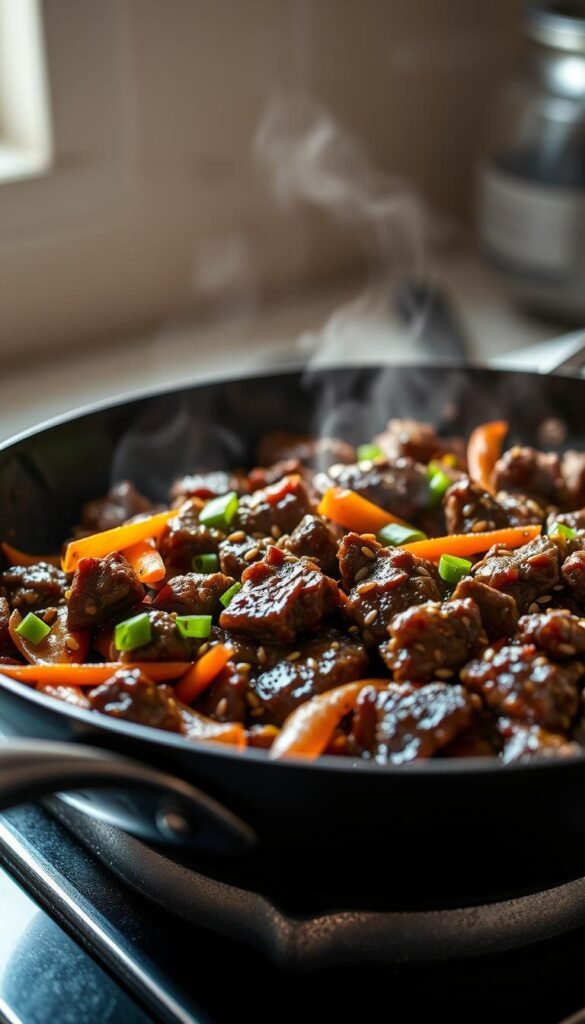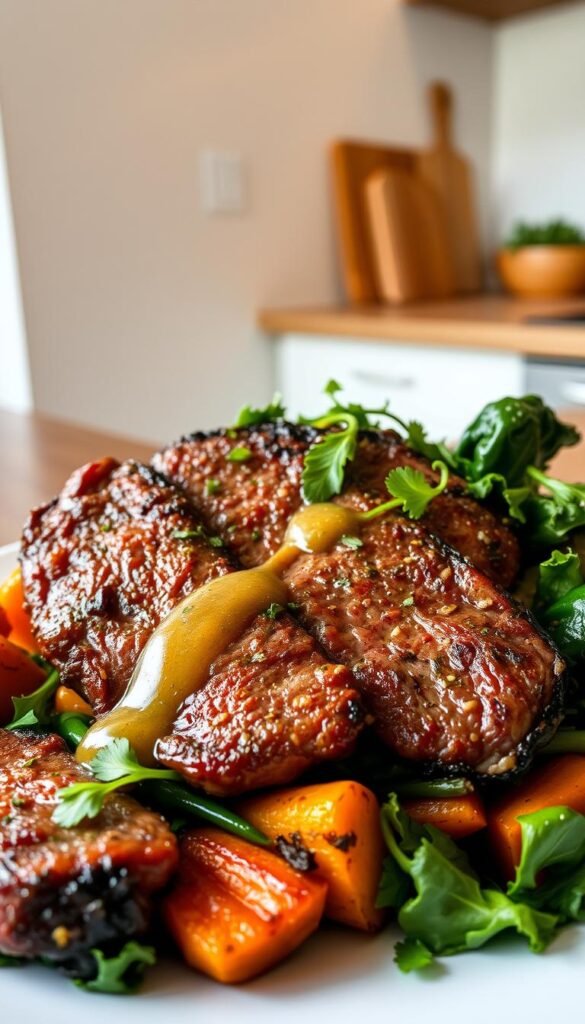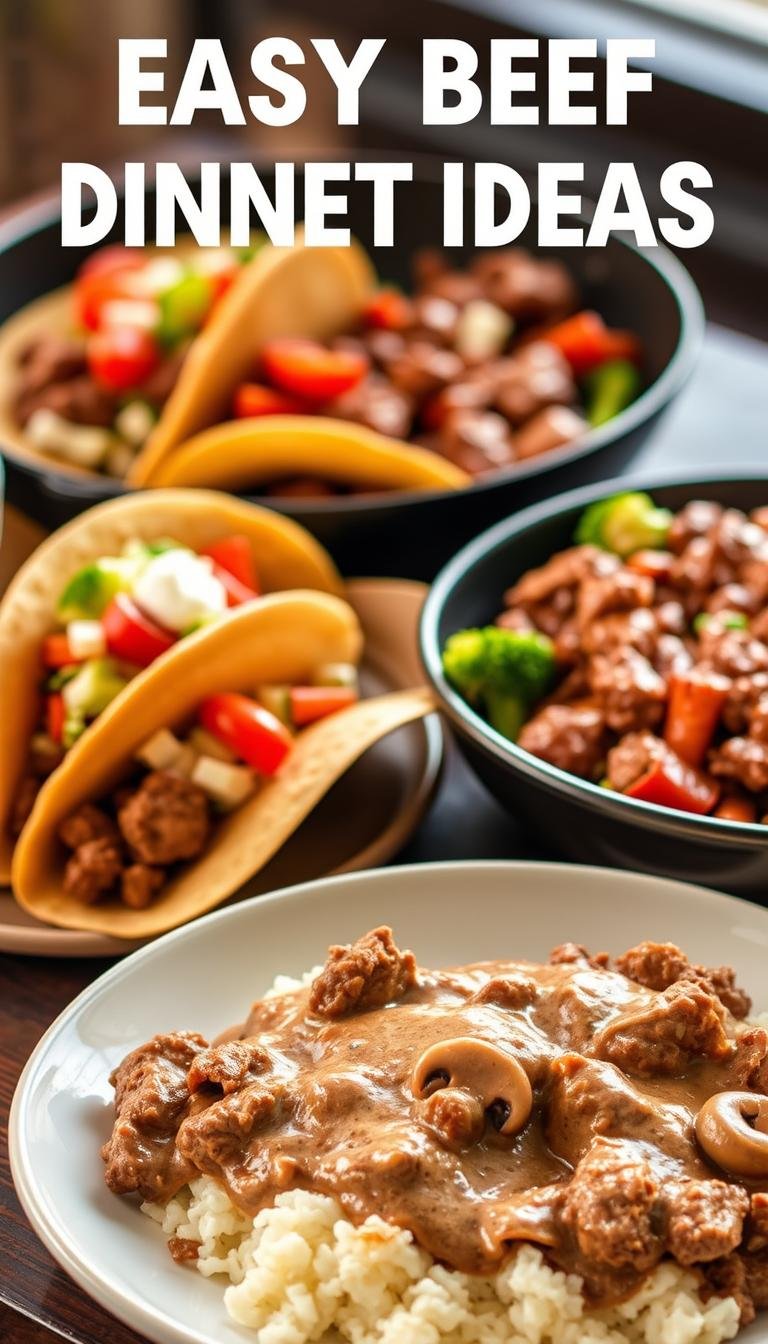Easy Dinner Ideas with Beef for a Quick Weeknight Meal
Surprising fact: over half of home cooks say a tasty stovetop meal in under 30 minutes keeps weeknights on track — and two fast techniques deliver that every time.
This guide focuses on two go-to methods: a thin-sliced steak stir-fry and a one-skillet ground beef bowl. Both finish in about 20–30 minutes and rely on quick searing plus a glossy, restaurant-style sauce.
Key pantry items—low sodium soy or tamari, brown sugar, garlic, ginger, and cornstarch—turn simple ingredients into big flavor. Thin steak tossed in cornstarch makes a tender bite, while browned ground beef soaks up an orange-tinged glaze that coats rice or lettuce wraps.
Expect practical how-to steps: time-saving prep, pantry-smart swaps, and reheating tips so leftovers stay great for 2–3 months frozen. Pick one dish tonight and keep the other ready for future weeknight relief.
Key Takeaways
- Two fast stovetop methods: thin-sliced steak stir-fry and skillet ground beef.
- Sauces form quickly from pantry staples for big flavor in minutes.
- Serve over rice, noodles, or in lettuce wraps for flexible meals.
- Prep shortcuts and batch sauce make weeknight cooking easier.
- Both dishes reheat well and freeze for 2–3 months.
Why Quick Beef Dinners Work on Busy Weeknights
Quick sears and a simple sauce transform thin slices or crumbled meat into a takeout-style plate in under half an hour. Thin steak and ground beef both reach full flavor fast, so the whole family gets fed without long prep.
High heat matters. A hot pan or skillet gives rapid browning and seals juices. Cook thin slices in batches to avoid steaming, and brown ground meat in just 3–5 minutes.
Aromatics like garlic bloom in hot oil in seconds, and a sauce made from soy sauce, water, and a touch of sugar reduces to a glossy finish in minutes. Start jasmine or white rice first so it’s ready when the skillet finishes.
- Proper technique cuts active time: sear, sauté, and simmer in short bursts.
- One pan, predictable timing, and scalable portions make this recipe reliable for weeknight routines.
How to Plan Faster Weeknight Meals with Beef
Stocking smart lets you move from fridge to table in minutes. Keep core ingredients on hand so a reliable recipe is always an option. Low‑sodium soy or tamari, light brown sugar, fresh garlic, grated ginger, cornstarch, and a neutral oil form the backbone of both thin‑slice and ground‑meat preparations.
Prep ahead to cut active time. Slice steak 1/4″ against the grain and toss in cornstarch, then set aside in an airtight container for up to a day. Some cooks shake coated slices in a resealable bag for even coverage and minimal mess.
- Pre-measure staples: keep labeled jars or a small bin for soy, sugar, and cornstarch so you shave off minutes during the rush.
- Whisk sauces: combine soy, orange juice, brown sugar, sweet chili, sesame oil, and cornstarch for the ground version; store in a small container for instant assembly.
- Trim and portion: remove visible fat to reduce splatter, then portion proteins so they cook quickly and evenly.
- Stage ingredients: use a tiny prep tray and start rice in parallel so everything finishes together.
Core Stir-Fry Technique: High Heat, Fast Cook, Big Flavor
Start by heating your skillet until it shimmers — that instant sear makes all the difference in texture. Preheat the pan over medium-high heat so the surface is hot before you add oil. A hot surface creates quick browning and helps the meat stay juicy.
Preheat a skillet and avoid crowding
Use a neutral oil with a high smoke point and add it once the pan is hot. Cook in small batches to prevent steaming. Keeping the pan temperature steady gives you deeper browning and better overall flavor.
Cornstarch coating to tenderize and thicken
Toss thin slices in a light dusting of cornstarch. This tenderizes and forms a barrier that helps the sauce cling. Shake off excess so searing is fast and surfaces crisp.
Build a balanced sauce
Sauté garlic and ginger briefly, then add low sodium soy sauce, water, and brown sugar. Bring the sauce to a boil to dissolve sugar, then remove it while you sear the meat. Return the sauce to the pan and simmer until it glazes the slices. The right reduction will coat a spoon and give glossy finish.
- Quick tip: alternate burner heat between batches so the pan stays hot but never scorched.
- Timing: prep all components before you sear so cooking moves without stops.
| Step | Why it matters | Quick result |
|---|---|---|
| Preheat pan | Ensures immediate sear | Deep browning, locked juices |
| Cook in batches | Prevents steaming | Improved texture |
| Cornstarch coat | Tenderizes and grips sauce | Silky, clingy glaze |
Dinner Ideas with Beef: Two 30-Minute Classics
Two classic 30-minute plates show how fast techniques and a bright sauce can turn thin steak or crumbled meat into a weeknight win.
Mongolian Beef: sweet-savory, finished with green onions
Mongolian Beef uses thin-sliced flank or NY strip tossed in cornstarch, then seared fast for a crisp edge. A sauce of low sodium soy sauce, water, brown sugar, garlic, and ginger reduces to a glossy glaze.
Finish by tossing in green onions. Serve over steamed rice or quick noodles and add broccoli or sliced red pepper for color. Add red pepper flakes or chili oil to taste.
Korean Ground Beef: bulgogi vibes in one skillet
Brown ground meat with garlic, then whisk soy sauce, orange juice, brown sugar, sweet chili sauce, sesame oil, and cornstarch. Simmer until thick and shiny.
This one-skillet beef recipe is perfect over rice, tossed with noodles, or spooned into lettuce wraps for a lighter plate.
- Speed: both recipes finish in roughly 30 minutes.
- Flexibility: add vegetables, change sweetness, or scale the sauce.
- Sodium control: choose low sodium soy and adjust salt near the end.
| Recipe | Main protein | Finish | Serve |
|---|---|---|---|
| Mongolian Beef | Thin-sliced steak | Green onions, glossy sauce | Rice or noodles |
| Korean Ground Beef | Ground beef | Sesame oil, quick glaze | Rice, noodles, or lettuce wraps |
Step-by-Step: Mongolian Beef on the Stove
Follow a simple routine—slice, coat, and sear—to get a glossy sauce and tender meat in under 30 minutes.
Prep and coat
Slice steak 1/4-inch against the grain, pat dry, then toss lightly in cornstarch and set aside. This creates a thin barrier that helps the sauce cling and keeps the texture tender.
Build the quick sauce
Heat a skillet or pan over medium-high heat and add a thin sheen of oil. Sauté garlic and ginger about 1 minute until aromatic.
Stir in low-sodium soy sauce (about 1/3 cup), water (1/4 cup), and light brown sugar (1/4 cup). Bring to a quick boil so the sugar dissolves, then remove the sauce from the heat while you sear the meat.
Sear, combine, and finish
Sear the coated slices in batches, 1–2 minutes per side, so each piece browns instead of steams. Return all meat to the pan, pour the sauce back in, and simmer 1–2 minutes until the sauce thickens and coats the back of a spoon.
Fold in 1-inch green onions and cook 1 minute more. Taste and add a pinch of salt or a few pepper flakes if you want heat. Serve immediately over steamed rice or noodles and reserve a cup of cooked rice for lunches.
Step-by-Step: Korean Ground Beef in One Skillet
This one-skillet method turns simple crumbles into a glossy, takeout-style plate in under half an hour.
Start: Heat a pan over medium-high heat and add a little oil. Brown the ground beef with minced garlic for about 3–5 minutes, breaking it into small crumbles.
Drain excess fat to keep the sauce balanced. Return the pan to heat so cooking resumes quickly.
Whisk the sauce
In a cup or small bowl whisk: 1/2 cup soy, 1/2 cup orange juice, 1/2 cup brown sugar, 1/4 cup sweet chili sauce, 2 tsp sesame oil, and 1 tablespoon cornstarch until smooth.
Simmer and finish
Pour the sauce over the cooked meat and simmer a few minutes until you see the sauce thicken and cling to the crumbles.
Off heat, stir in sliced green onions and a splash more sesame oil. Add a pinch of pepper flakes if you want heat.
- Serve over rice or spoon into lettuce wraps for a lighter option.
- Keep leftovers cool, then freeze up to 3 months for easy meals.
| Step | Time | Why |
|---|---|---|
| Brown beef & garlic | 3–5 minutes | Develops flavor, prevents soggy texture |
| Whisk sauce | 2 minutes | Ensures smooth mix and even thickening |
| Simmer to sauce thicken | 2–4 minutes | Coats crumbles and gives glossy finish |

Turn Up the Flavor: Heat, Veggies, and Swaps
Adjusting heat and adding fresh produce is the fastest way to upgrade a pan sauce. Small changes bring bold results and keep the plate balanced.
Spice it up: Add crushed red pepper flakes, a drizzle of chili oil, or a few dried Thai chiles right after the garlic so the heat infuses the sauce without tasting raw. For milder warmth, use less pepper flakes and finish with a pinch at the table.
Add veggies: Toss in broccoli florets, sliced red pepper, spinach, or mushrooms for color and texture. Steam denser pieces briefly, then fold them into the sauce at the end so they stay crisp-tender.
Serving and swaps
- Serve over rice, toss with rice noodles or chow mein, or spoon into lettuce wraps for a lighter plate.
- Use a hot pan and work in small batches so added veggies don’t cool the mixture.
- Swap in chicken when beef is not available; reduce cook time to keep it tender.
| Add-in | When to add | Effect on dish |
|---|---|---|
| Crushed red pepper flakes | After garlic | Builds steady heat without bitterness |
| Broccoli / red pepper | Steam then finish in sauce | Color, crunch, nutrition |
| Chili oil | As a finisher | Layered heat and glossy sheen |
| Rice noodles / chow mein | Toss just before serving | Soaks up sauce, adds body |
Healthier Tweaks Without Losing Flavor
A few targeted swaps keep the same bold taste while trimming calories and sodium.
Choose low‑sodium soy or tamari to cut sodium but keep umami in the sauce. Start with less sugar and salt, then taste and adjust at the end so the balance stays bright.
Pick leaner cuts or swap in ground turkey to lower calories and fat. When browning crumbled meat, drain excess grease to control richness and keep the sauce from getting greasy.
Use a measured tablespoon of oil to sauté aromatics rather than pouring freely. Lean on acidity—orange juice or a splash of rice vinegar—to lift flavor so you need less salt.
Finish a recipe with fresh herbs and aromatics instead of more salt. Green onions and toasted sesame seeds add texture and a savory finish to the dish.

| Swap | Benefit | How to do it |
|---|---|---|
| Low‑sodium soy/tamari | Lower sodium | Use same amount, taste before adding salt |
| Lean cuts / ground turkey | Fewer calories & less fat | Trim visible fat or choose 90% lean |
| Measured oil & drain fat | Control richness | Use 1 Tbsp oil; drain crumbles after browning |
Make-Ahead, Storage, and Freezer Tips
Good storage preserves texture and keeps flavors bold. Follow a few small rules to keep seared meat and a glossy sauce tasting near‑fresh after reheating.
Refrigerate smartly
Store cooked meat in an airtight container for 3–4 days. Label the container with the date so you rotate meals easily. Portion rice into separate cups or small containers to avoid soggy grains.
Freeze for longer
Cool food completely, then press out air and seal in a freezer bag or a rigid container. Freeze for 2–3 months for best quality. Thaw overnight in the fridge before reheating.
Reheat for best texture
Warm a pan or skillet over medium heat and add a touch of oil or a splash of water. Reheat gently for a few minutes until hot. Avoid over-reducing the sauce so the meat stays moist.
“Batch-cook and chill sauce separately; warm it before combining with freshly seared meat to preserve crisp edges.”
- Keep sauce in a separate cup or jar for up to 5 days; heat before adding to meat.
- If steak was tossed in cornstarch, store sauce apart to keep edges crisp.
- Rotate freezer inventory so meals stay within the ideal window.
| Storage | Container type | Max fridge | Max freezer |
|---|---|---|---|
| Cooked beef portions | Airtight container | 3–4 days | 2–3 months |
| Sauce (separate) | Small jar or cup | Up to 5 days | 2 months |
| Rice (portioned) | Small container/cup | 3–4 days | 2–3 months |
Suggested Sides and Pairings for a Complete Meal
The right side dishes amplify sauce and texture, making a weeknight skillet feel complete. Pick one starch, one green, and a small crisp garnish to create balance without extra fuss.
Starches: rice and noodles that soak up sauce
Serve Mongolian-style beef over steamed jasmine or brown rice so every bite gets a glossy finish. Use a measured cup to portion rice for even plates.
Garlic noodles or chow mein make a comforting match. Toss noodles in a little sauce from the pan so they carry savory-sweet notes through the whole meal.
Quick veggies and light options
Keep veggie sides fast: steamed broccoli, sautéed green beans, or snap peas cook in minutes and cut richness.
For a lighter plate, try lettuce wraps spooned with meat and topped with sliced green onions. Add a pinch of pepper or chili at the table so each person adjusts heat and flavor.
- Warm rice in a covered pan with a splash of water to refresh it.
- Serve sauces tableside for drizzling so sides stay vibrant.
- Contrast textures: crisp veggies plus chewy noodles lift the main dish without complexity.
Conclusion
,These two skillet methods give you fast, restaurant-style results using staples from your pantry.
Both recipes finish in 20–30 minutes and rely on a quick sear and a glossy sauce to deliver big flavor. The frameworks are flexible: swap vegetables, rotate rice or noodles, or use chicken to change the protein.
Keep low sodium soy and tweak sugar to control sodium and calories without losing taste. Finish plates with sliced onions, a pinch of pepper, or light flakes to add brightness and heat.
Prep ahead and freeze portions to simplify future meals. With these steps, your next weeknight meal is faster, reliable, and flavorful.






